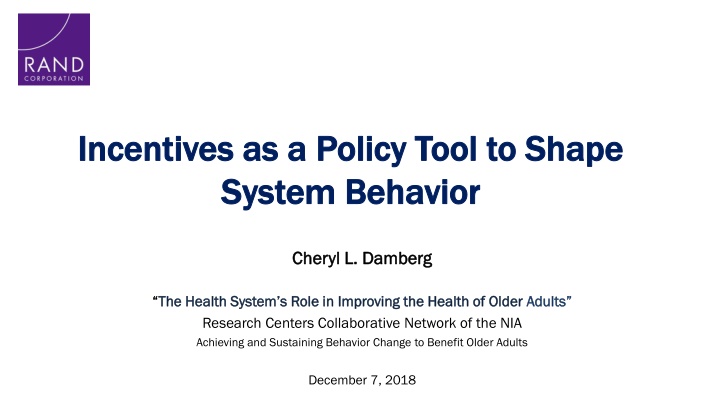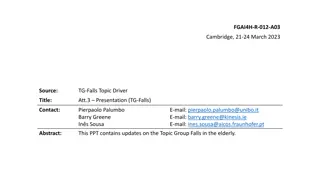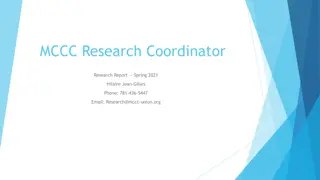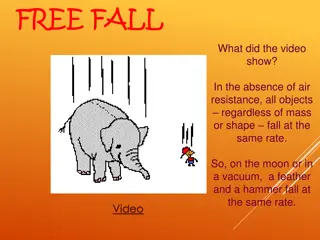
State of the College Fall 2017 Convocation
The State of the College Fall 2017 Convocation on August 22, 2017, was a gathering where Dr. Veronica Garcia welcomed back faculty and over XXX new students through NSO. The event also included a 10th-anniversary planning session continuing with various activities such as Summer Science Research, Processing Financial Aid, Drone Camp, and Youth Summer Interns. The focus was on innovative programs like Underwater Robotics and engaging the college community in events like 5K runs and galas.
Uploaded on | 0 Views
Download Presentation

Please find below an Image/Link to download the presentation.
The content on the website is provided AS IS for your information and personal use only. It may not be sold, licensed, or shared on other websites without obtaining consent from the author. If you encounter any issues during the download, it is possible that the publisher has removed the file from their server.
You are allowed to download the files provided on this website for personal or commercial use, subject to the condition that they are used lawfully. All files are the property of their respective owners.
The content on the website is provided AS IS for your information and personal use only. It may not be sold, licensed, or shared on other websites without obtaining consent from the author.
E N D
Presentation Transcript
Incentives as a Policy Tool to Shape Incentives as a Policy Tool to Shape System Behavior System Behavior Cheryl L. Damberg Cheryl L. Damberg The Health System s Role in Improving the Health of Older The Health System s Role in Improving the Health of Older Adults Research Centers Collaborative Network of the NIA Achieving and Sustaining Behavior Change to Benefit Older Adults Adults December 7, 2018
What are We Paying for When We Pay Providers? What are We Paying for When We Pay Providers? A physician s time? A unit of treatment delivered? Measurable improvement in our health? Something else? Cheryl Damberg, "Achieving and Sustaining Behavior Change to Benefit Older Adults" Dec 6-7, 2018
Health Care Payment Models have been Evolving Health Care Payment Models have been Evolving Pay for performance Pay for value Fee for service 3 Cheryl Damberg, "Achieving and Sustaining Behavior Change to Benefit Older Adults" Dec 6-7, 2018
How are Incentives Shaping Health System Behaviors? How are Incentives Shaping Health System Behaviors? Actions to reduce total costs of care Improve hand-off at discharge (transition clinics) Tighter management of complex patients in the community Use multi-disciplinary care teams in ambulatory setting Shift management of complex patients from PCP to central team Reduce the number of specialists and capitate specialists Actions to redesign primary care: Case management of high risk patients Team-based care Using data analytics to identify high risk patients Telehealth Task shifting (working to highest level of licensure) Open access appointments Cheryl Damberg, "Achieving and Sustaining Behavior Change to Benefit Older Adults" Dec 6-7, 2018
Do Pay Do Pay- -for for- -Performance Incentives Work? Performance Incentives Work? Evaluations mostly observational studies with numerous issues Lack of good control group, short term interventions, few measures examined, different implementation contexts and design approaches Bottom line: P4P did not transform care delivery as hoped! Bottom line: P4P did not transform care delivery as hoped! Ambulatory setting Ambulatory setting: Evidence on impacts is mixed. Modest improvements on process measures. No consistent effect on intermediate health outcomes. Hospital setting: Hospital setting: Public reporting had larger effect than financial payments. Process measures quickly topped out due to hospital s ability to control the patient. Little evidence of effects on health outcomes, save for hospital readmissions. Incentives mostly small, raising questions about whether larger incentives would create more engagement and greater improvement Cheryl Damberg, "Achieving and Sustaining Behavior Change to Benefit Older Adults" Dec 6-7, 2018 Source: A. Mendelson, K Kondo, C Damberg et al. The effects of Pay-for-Performance Programs on Health, Health Care Use, and Processes of Care: A Systematic Review. Annals of Internal Medicine, 2017.
Why Dont Incentives Work as Desired? Why Don t Incentives Work as Desired? Incentives seek to influence human/organizational motivation Typically structured as contingent rewards --work best in situations with simple rules For conceptual problems that require cognitive skills, incentives lead to poorer performance Hierarchical principal-agent incentive structure: At the system level, may encourage investments in infrastructure and quality improvement At provider level, may not motivate people and may decrease intrinsic motivation (Irlenbusch, 2009; Pink, 2009) Incentives mostly built on a fee-for-service (FFS) payment structure Doesn t give providers the flexibility to deliver the highest value services that would improve the health of patients (e.g., community services) Cheryl Damberg, "Achieving and Sustaining Behavior Change to Benefit Older Adults" Dec 6-7, 2018 Sources: B Irlenbusch, London School of Economic s Department of Management, 2009. Daniel Pink, Drive, 2009.
Areas of Controversy Areas of Controversy If you make incentives larger, that will lead providers to make changes Introduces undesirable incentives for providers that could harm patients Doesn t fix the underlying base payment problem, which remains mostly FFS Lack of accountability for appropriateness of services and health outcomes measuring the wrong things Incentives may discourage providers for caring for certain types of patients Held accountable for things they can t control Could lead to undesired effects unless risk-adjust measures for greater complexity and social determinants Performance measures don t account for important exclusions, namely patient preferences given treatment and side-effect tradeoffs particularly important among the older population Other strategies may be more effective in driving desired changes among frontline physicians this area requires more exploration! Cheryl Damberg, "Achieving and Sustaining Behavior Change to Benefit Older Adults" Dec 6-7, 2018
Alternative Approaches that Shift Towards Paying for Value Alternative Approaches that Shift Towards Paying for Value Cheryl Damberg, "Achieving and Sustaining Behavior Change to Benefit Older Adults" Dec 6-7, 2018
What are the Concerns with Alternative Payment Models What are the Concerns with Alternative Payment Models that Pay for Quality or Value? that Pay for Quality or Value? Source: Harold Miller. Why Value-based Payment Isn t Working and How to Fix it. Center for Healthcare Quality and Payment Reform Cheryl Damberg, "Achieving and Sustaining Behavior Change to Benefit Older Adults" Dec 6-7, 2018
Reconsidering what we Pay for and Incentivize Reconsidering what we Pay for and Incentivize Future State: Measure and pay for preserving health Current State: Focus on delivering more services Medical Treatment Prevention & Management Sick Care Health care Cheryl Damberg, "Achieving and Sustaining Behavior Change to Benefit Older Adults" Dec 6-7, 2018
Areas of Opportunity for Multidisciplinary Collaboration Areas of Opportunity for Multidisciplinary Collaboration Identify important patient health outcomes and systematically measure those Develop patient-centered measures of health outcomes tailored to individual preferences for treatment Conduct research applying behavioral economics/behavioral science to identify other effective approaches to driving desired behaviors (e.g., changing the choice architecture, structuring information) Map out a road map to revamp payments to health systems and providers to pay for health Engage patients in maintaining health---this requires active communication and applying what we know about how to communicate Cheryl Damberg, "Achieving and Sustaining Behavior Change to Benefit Older Adults" Dec 6-7, 2018
damberg@rand.org Cheryl Damberg, "Achieving and Sustaining Behavior Change to Benefit Older Adults" Dec 6-7, 2018






















